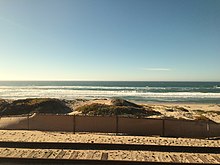Surf, California
Surf, California | |
|---|---|
Former community | |
 Surf Amtrak Station | |
 Surf, California | |
| Coordinates: 34°41′04″N 120°36′13″W / 34.6844268°N 120.6035029°WCoordinates: 34°41′04″N 120°36′13″W / 34.6844268°N 120.6035029°W | |
| Country | United States |
| State | California |
| County | Santa Barbara |
| Elevation | 59 ft (18 m) |
| Time zone | UTC-8 (Pacific (PST)) |
| • Summer (DST) | UTC-7 (PDT) |
| Area code(s) | 805 & 820 |
| GNIS feature ID | 250152[1] |

Surf is a former settlement in an unincorporated area of Santa Barbara County, California,[2] located along the Pacific coast within Vandenberg Space Force Base west of the city of Lompoc. Surf Beach provides access to the Pacific Ocean. There is a parking lot and the unstaffed Surf Amtrak Station. California State Route 246 used to run to Surf, but in 1984 the highway was truncated at Lompoc and the road from Lompoc to Surf is designated West Ocean Avenue.
Sections of Surf Beach are closed between March 1 and September 30 every year during the nesting season of the western snowy plover.[3] The closures are in place to protect the bird under the Endangered Species Act. If a set number of trespass violations have been reached during any nesting season (currently 50), the beach is closed entirely.[4][5]
History[]
Surf grew as a railway town to accommodate the personnel needed to maintain the trains and tracks after Southern Pacific Railroad built a station here for its Coast Line in 1900.[6] In 1909, the schooner cargo ship Sibyl Marston sank off the coast south from Surf.[7] The station at Surf became popular with U.S. Army soldiers stationed at Camp Cooke (now Vandenberg Space Force Base) during World War II. The population of the town peaked at 40, with most residents being employed with the railroad. As trains modernized, Surf experienced depopulation, to the point where Southern Pacific was only operating a telegraph station.[6] The telegraph station closed in 1985, and it was not until 2000 that the current Surf Amtrak Station was completed. The unstaffed Amtrak station is currently the only structure left standing in Surf.[8]
Two fatal shark attacks have occurred near Surf Beach: one on October 22, 2010, and the other on October 23, 2012.[9] Travel + Leisure has listed it as one of the worst beaches for shark attacks.[10]
See also[]
References[]
- ^ "Surf". Geographic Names Information System. United States Geological Survey.
- ^ U.S. Geological Survey Geographic Names Information System: Surf, California
- ^ Jacobson, Willis (September 24, 2019). "Major changes at Lompoc's Surf Beach could include shift in plover counts, construction of boardwalk". Santa Maria Times. Retrieved 2019-09-26.
- ^ "Vandenberg Beaches to close for Annual Snowy Plover Nesting Season". Vandenberg Air Force Base. March 1, 2012. Archived from the original on November 4, 2013. Retrieved October 23, 2012.
- ^ Connell, Sally Ann (June 16, 2002). "It's Birds vs. Bathers on Remote Beach". Los Angeles Times. Retrieved 8 May 2017.
- ^ a b Wallace, Glenn (March 3, 2008). "Train buff takes story of Surf across nation". Lompoc Record. Retrieved August 12, 2014.
- ^ Nisperos, Neil (January 29, 2008). "Merchant steamer ship visible at Surf Beach". Lompoc Record. Retrieved August 12, 2014.
- ^ "Lompoc-Surf". GreatAmericanStations.com. Amtrak. Retrieved August 12, 2014.
- ^ "'Great White Serial Killer' probes Surf Beach deaths". Santa Maria Times. August 4, 2013. Retrieved August 12, 2014.
- ^ "Worst Beaches for Shark Attacks: Surf Beach". Travel + Leisure. August 2011. Retrieved August 12, 2014.
- Beaches of Southern California
- Unincorporated communities in Santa Barbara County, California
- Unincorporated communities in California
- Beaches of Santa Barbara County, California
- Santa Barbara County, California geography stubs


